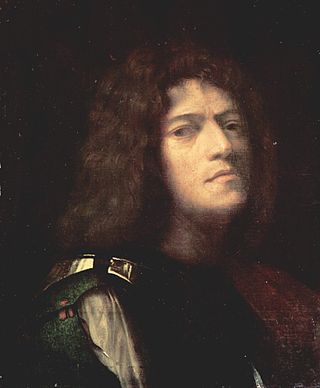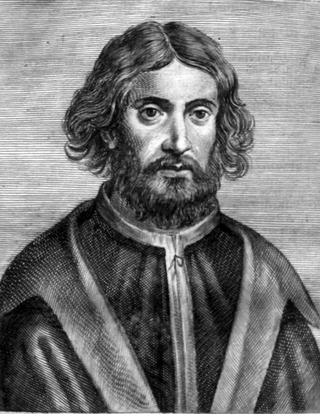
Gerard David was an Early Netherlandish painter and manuscript illuminator known for his brilliant use of color. Only a bare outline of his life survives, although some facts are known. He may have been the Meester gheraet van brugghe who became a master of the Antwerp guild in 1515. He was very successful in his lifetime and probably ran two workshops, in Antwerp and Bruges. Like many painters of his period, his reputation diminished in the 17th century until he was rediscovered in the 19th century.

Alessandro di Mariano di Vanni Filipepi, better known as Sandro Botticelli or simply Botticelli, was an Italian painter of the Early Renaissance. Botticelli's posthumous reputation suffered until the late 19th century, when he was rediscovered by the Pre-Raphaelites who stimulated a reappraisal of his work. Since then, his paintings have been seen to represent the linear grace of late Italian Gothic and some Early Renaissance painting, even though they date from the latter half of the Italian Renaissance period.

Lucas Cranach the Elder was a German Renaissance painter and printmaker in woodcut and engraving. He was court painter to the Electors of Saxony for most of his career, and is known for his portraits, both of German princes and those of the leaders of the Protestant Reformation, whose cause he embraced with enthusiasm. He was a close friend of Martin Luther. Cranach also painted religious subjects, first in the Catholic tradition, and later trying to find new ways of conveying Lutheran religious concerns in art. He continued throughout his career to paint nude subjects drawn from mythology and religion.

Giorgione was an Italian painter of the Venetian school during the High Renaissance, who died in his thirties. He is known for the elusive poetic quality of his work, though only about six surviving paintings are firmly attributed to him. The uncertainty surrounding the identity and meaning of his work has made Giorgione one of the most mysterious figures in European art.

Adriaen Isenbrandt or Adriaen Ysenbrandt was a painter in Bruges, in the final years of Early Netherlandish painting, and the first of the Dutch and Flemish Renaissance painting of the Northern Renaissance. Documentary evidence suggests he was a significant and successful artist of his period, even though no specific works by his hand are clearly documented. Art historians have conjectured that he operated a large workshop specializing in religious subjects and devotional paintings, which were executed in a conservative style in the tradition of the Early Netherlandish painting of the previous century. By his time, the new booming economy of Antwerp had made this the centre of painting in the Low Countries, but the previous centre of Bruges retained considerable prestige.

Pietro Perugino, born Pietro Vannucci, was an Italian Renaissance painter of the Umbrian school, who developed some of the qualities that found classic expression in the High Renaissance. Raphael was his most famous pupil.

A court painter was an artist who painted for the members of a royal or princely family, sometimes on a fixed salary and on an exclusive basis where the artist was not supposed to undertake other work. Painters were the most common, but the court artist might also be a court sculptor. In Western Europe, the role began to emerge in the mid-13th century. By the Renaissance, portraits, mainly of the family, made up an increasingly large part of their commissions, and in the Early Modern period one person might be appointed solely to do portraits, and another for other work, such as decorating new buildings.

Rembrandt Harmenszoon van Rijn, usually simply known as Rembrandt, was a Dutch Golden Age painter, printmaker, and draughtsman. An innovative and prolific master in three media, he is generally considered one of the greatest visual artists in the history of art. It is estimated Rembrandt produced a total of about three hundred paintings, three hundred etchings, and two thousand drawings.

Antwerp Mannerism is the name given to the style of a group of largely anonymous painters active in the Southern Netherlands and principally in Antwerp in roughly the first three decades of the 16th century, a movement marking the tail end of Early Netherlandish painting, and an early phase within Dutch and Flemish Renaissance painting. The style bore no relation to Italian Mannerism, which it mostly predates by a few years, but the name suggests that it was a reaction to the "classic" style of the earlier Flemish painters, just as the Italian Mannerists were reacting to, or trying to go beyond, the classicism of High Renaissance art.

Giovanni Antonio Boltraffio was an Italian painter of the High Renaissance from Lombardy, who worked in the studio of Leonardo da Vinci. Boltraffio and Bernardino Luini are the strongest artistic personalities to emerge from Leonardo's studio. According to Giorgio Vasari, he was of an aristocratic family and was born in Milan.

Jacob Cornelisz van Oostsanen was a Northern Netherlandish designer of woodcuts and painter. He was one of the first important artists working in Amsterdam, at a time when it was a flourishing and beautiful provincial town.

Michael Sittow, also known as Master Michiel, Michel Sittow, Michiel, Miguel, and several other variants, was a painter from Reval (Tallinn), Estonia who was trained in the tradition of Early Netherlandish painting. For most of his life, Sittow worked as a court portrait painter, for Isabella of Castile, the Habsburgs, and other prominent royal houses in Spain and the Netherlands. He is considered one of the most important Flemish painters of the era.

The Life of the Virgin, showing narrative scenes from the life of Mary, the mother of Jesus, is a common subject for pictorial cycles in Christian art, often complementing, or forming part of, a cycle on the Life of Christ. In both cases the number of scenes shown varies greatly with the space available. Works may be in any medium: frescoed church walls and series of old master prints have many of the fullest cycles, but panel painting, stained glass, illuminated manuscripts, tapestries, stone sculptures and ivory carvings have many examples.

The Master of Affligem or Master of the Joseph Sequence was an accomplished painter of the South Netherlandish school, apparently working in Brussels, whose name is not known, but whose hand can be detected in a number of surviving paintings on panel. The pseudonym Master of the Joseph Sequence was given him as a name of convenience in 1923 by Walter Friedländer, who identified a series of tondi illustrating the Legend of St Joseph, which had become scattered among several museums, as all coming from the same painter. Subsequently Friedländer attributed to the same workshop eight further panels with scenes from two other sequences, the Life of Christ and the Life of the Virgin These came from the abbey of Affligem in Brabant, providing the alternate name for the artist.

Palma Vecchio, born Jacopo Palma, also known as Jacopo Negretti, was a Venetian painter of the Italian High Renaissance. He is called Palma Vecchio in English and Palma il Vecchio in Italian to distinguish him from Palma il Giovane, his great-nephew, who was also a painter.

Colijn de Coter was an early Netherlandish painter who produced mainly altarpieces. He worked primarily in Brussels and Antwerp. His name was sometimes given as Colijn van Brusele, indicating that he hailed from Brussels or at least that he lived there most of his active life. He also signed several paintings with Coliin de Coter pinxit me in Brabancia Bruselle.

Ambrosius Benson was an Italian painter who became a part of the Northern Renaissance.

Woutherus Mol was a painter and draftsman from the Netherlands. He is known for interiors and genre scenes.

The Master of the Prado Adoration of the Magi was a Netherlandish painter active between c. 1475 and 1500 whose identity is now lost. He is thought to have originated from the southern Netherlands and is known for his vibrant colourisation in panels depicting scenes from the infancy of Christ, he is thought to have been a pupil of Rogier van der Weyden, and is named after a copy of the "Adoration of the Magi" panel from that painter's St Columba Altarpiece. Although the Magi became a popular topic for northern painters in the second half of the 15th century and the Columba altarpiece was widely copied, the master is associated with van der Weyden's workshop because the copy is so close, it is believed he must have had access to a reproduction of the underdrawing.

The Master of the Legend of Saint Bruno is the "notname" of an anonymous Gothic painter who was active in Cologne in the late 15th century. He is best known for the cycle of paintings on canvas produced for Cologne Charterhouse after which he is named.




















